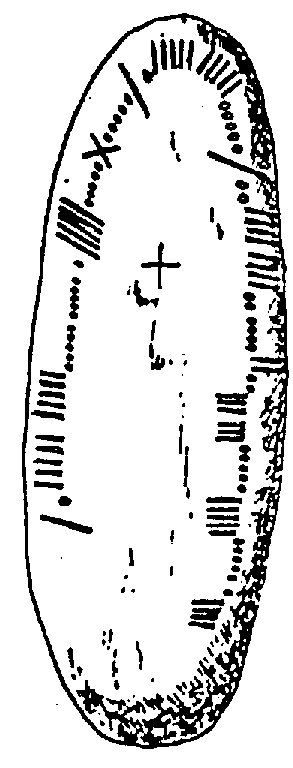Ballintaggart Ogham Stones facts for kids
Quick facts for kids Ballintaggart Ogham Stones |
|
|---|---|
| Native name Irish: Clocha Oghaim Bhaile an tSagairt |
|

CIIC 156, bearing the name of the Corcu Duibne
|
|
| Type | ogham stones |
| Location | Ballintaggart, Dingle, County Kerry, Ireland |
| Elevation | 51 m (167 ft) |
| Built | AD 400–550 |
| Owner | private |
| Official name: Ballintaggart Ogham Stones | |
| Reference no. | 64 |
| Lua error in Module:Location_map at line 420: attempt to index field 'wikibase' (a nil value). | |
The Ballintaggart Ogham Stones are a special group of ancient stones found in County Kerry, Ireland. These stones are very old and have a unique type of writing carved into them called ogham. They are so important that they are protected as a National Monument of Ireland.
Ogham is an ancient alphabet that was used mainly in early medieval Ireland. It's made up of lines and notches carved along the edge of a stone. Think of it like a secret code from a long, long time ago!
Contents
Where are the Ballintaggart Ogham Stones?
The Ballintaggart Ogham Stones are located in a place called Ballintaggart, near the town of Dingle. They sit inside a large, round area that is about 30 meters (100 feet) across. This area is just east of the Dingle racecourse. It's a peaceful spot where these ancient markers have stood for centuries.
What's the History of These Stones?
These amazing stones were carved a very long time ago, between the years 400 and 550 AD. That's about 1,500 to 1,600 years ago! They were mostly used as markers for graves, helping people remember those who had passed away.
The area where the stones are found was once a very important place. It used to be the site of an old church and a burial ground. People called this old burial ground An Cheallúnach or An Lisín. It shows that this spot has been special to people for a very long time.
What Do the Stones Look Like?
The ogham stones at Ballintaggart are made from sandstone that has been smoothed by water. They are mostly rounded in shape. There are nine stones in total. Eight of them are arranged in a circle, lying down and pointing outwards. The ninth stone is right in the middle of the circle. Some of these stones also have crosses carved into them, which tells us about the beliefs of the people who made them.
What Do the Ogham Carvings Say?
Each stone has a unique message carved into it using the ogham alphabet. These messages often tell us the names of people or families from ancient times. Here are some of the things the stones say:
- CIIC 155: This stone likely has a personal name carved on it: AKEVRITTI.
- CIIC 156: This carving says: MAQQI-IARI KOỊ MA/QQI MU/CCOI DOVVINIAS. This means "Here is Mac-Iair, son of the Corcu Duibne." The Corcu Duibne were a powerful ancient kingdom or tribe in this part of Ireland.
- CIIC 157: This stone reads: DOVETI MAQQI/ CATTI/NI. This translates to "of Duibthe, son of Caitne." Experts believe this stone is very old, possibly from the time of Saint Patrick, because of the way the language is used.
- CIIC 158: This carving says: SUVALLOS MAQ/Q̣Ị DU/COVAROS. This means "of Suvallos son of Ducovaros."
- CIIC 159: This stone reads: ṂẠQI-DECC[E]DẠ/ ṂẠQ̣Ị/ GLASICONAS. This means "of son of Deichet, son of Glasiconas." The name Glasiconas is interesting because it means "grey wolf."
- CIIC 160: This stone has two parts: TRIA MAQA MAILAGNI (meaning "of the three sons of Maílagnas") and CURCITTI (meaning "of Cuircthe"). This stone also has a very unusual cross carved on it. The cross has arms of equal length, with different shapes on the ends of each arm.
- CIIC 161: This carving is a personal name: INISSIO/NAS. Like stone CIIC 157, this one also dates back to the 5th century AD.
- CIIC 162: This stone says: CUṆẠMAQQ̣I/ AVI CỌRBBI. This means "of Conmac, grandson of Corb."
- CIIC 163: This carving reads: N[E]TTA-LAMINACCA KO/I ṂA/QQI MỤCOI DOṾ[I]Ṇ[IA]Ṣ. This translates to "here is Laminacca's champion, son of the Corcu Duibne."
These ogham stones are like ancient messages from the past, giving us clues about the people who lived in Ireland many centuries ago. They are a wonderful link to history and a reminder of the unique culture of early Ireland.

